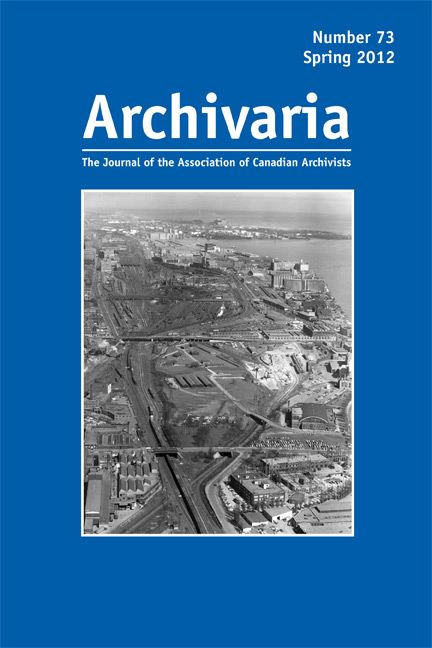Mémoire, archives et art contemporain
Abstract
Archives are intimately tied to memory. Indeed, the metaphor of archives as memory is frequently employed. The aim of this article is to identify the mechanisms at play in the relationship between archives and memory. First, we will survey the work of several archivists who have examined the question of memory from a postmodern perspective. Second, in light of this work, we will see that memory is a complex phenomenon and that, insofar as memory relates chiefly to process, archives are more like “memory factories” and, above all else, they serve as “a medium of memory.” Third, we will attempt to identify the aspects that characterize memory as a process and to measure the impacts on the relationship they establish with archives. To do this, we will evoke the use of archival documents by contemporary artists, a phenomenon which, despite the lack of interest that archivists have devoted to it, has been an important part of the artistic scene since the mid-1980s. Works produced by artists such as Angela Grauerholz, Raymonde April, Emmanuelle Léonard, Michel Campeau, Dominique Blain, Jeff Thomas, Christian Boltanski, and Patrick Altman will help us to better understand how memory comes to the archives, and to realize the open and constantly evolving nature of archives themselves.
RÉSUMÉ
Les archives sont intimement reliées à la mémoire. D’ailleurs, la métaphore des archives comme mémoire est fréquemment utilisée à cet effet. Le but de cet article est d’identifier les mécanismes qui sont en cause dans la relation entre les archives et la mémoire. Dans un premier temps, nous nous intéressons aux travaux de plusieurs archivistes qui, dans une optique postmoderne, ont examiné la question de la mémoire. Dans un deuxième temps, à la lumière de leurs réflexions, nous verrons que la mémoire est un phénomène complexe et que, dans la mesure où celle-ci tient principalement du processus, les archives sont davantage des « manufactures de la mémoire », qu’elles servent d’abord et avant tout de « véhicules de la mémoire ». Troisièmement, nous cherchons à dégager les aspects qui caractérisent la mémoire comme processus et à en mesurer les impacts sur la relation qui est établie avec les archives. Pour ce faire, nous ferons appel à l’utilisation des documents d’archives par les artistes contemporains, un phénomène qui, malgré le peu d’intérêt que lui ont porté les archivistes, occupe une place importante sur la scène artistique depuis le milieu des années 1980. Les oeuvres produites par des artistes tels que Angela Grauerholz, Raymonde April, Emmanuelle Léonard, Michel Campeau, Dominique Blain, Jeff Thomas, Christian Boltanski et Patrick Altman nous aideront à mieux comprendre comment la mémoire vient à l’archive ainsi qu’à nous rendre compte de la nature ouverte, en devenir, qui caractérise cette dernière.
Authors of manuscripts accepted for publication retain copyright in their work. They are required to sign the Agreement on Authors' Rights and Responsibilities that permits Archivaria to publish and disseminate the work in print and electronically. In the same agreement, authors are required to confirm that "the material submitted for publication in Archivaria, both in its paper and electronic versions, including reproductions of other works (e.g. photographs, maps, etc.) does not infringe upon any existing copyright." Authors of manuscripts accepted for publication retain copyright in their work and are able to publish their articles in institutional repositories or elsewhere as long as the piece is posted after its original appearance on archivaria.ca. Any reproduction within one year following the date of this agreement requires the permission of the General Editor.





